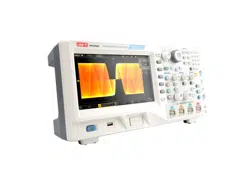Loading ...
Loading ...
Loading ...

35
Sample %:
Adjust the Multipurpose knob or shuttle knob to set the “Input -” sampling
point ratio (1%~99%).
Trigger Condition:
Press PgDn trigger condition to set CAN trigger condition: Frame start,
frame type, ID, data, missing ACK, fill error, ID and data, frame end.
Frame Start: Triggers at the start of the CAN protocol data frame.
Frame Type: Triggers on the specified frame type, including data frame,
remote frame, error frame, and overload frame.
ID: Set the ID for the specified frame type, and triggers on the specified ID.
Data: A 2-digit hexadecimal number of 1~8 bytes can be set. When the actual
CAN protocol signal and the set data meet the data qualification conditions,
a trigger occurs. The data qualification includes <, >, ≤, ≥, =, !=.
Missing ACK: Triggers when the ACK Field of the data frame is lost.
Fill Error: Since the CAN signal encoding uses bit stuffing, a complement
bit is inserted after every 5 identical bits, and it triggers when the complement
bit is filled incorrectly.
ID and Data: Triggers when it meets the ID and data conditions at the same time.
Frame end: Triggers at the end of the data frame.
Frame Type:
When the trigger condition is frame type, you can set data frame, remote
frame, error frame, and overload frame.
(1) Data Frame: Triggers on the data frame of the CAN protocol signal. The
data frame format is as follows:
(2) Remote Frame: Triggers on the remote frame of the CAN protocol signal.
Remote frames are the same as data frames except that there is no data
field. Remote frames and data frames are differentiated by the arbitration
field RTR bit.
(3) Error Frame: Triggers on the error frame of the CAN protocol signal. The
error frame is represented by a 6-bit continuous level that breaks the bit
stuffing rule followed by a recessive value (logic 1) of a minimum of 8 bits
as the error delimiter. Error frames are divided into active error frames
and passive error frames. Active error frames use 6-bit dominant values
(logic 0), and passive frames use recessive values.
(4) Overload Frame: Triggers on the overload frame of the CAN protocol
signal. The overload frame format is the same as the active error frame.
Press the type key and you can set the frame type.
ID Setting:
When the trigger condition is ID or ID/ data, ID setting is required.
Press PgDn ID setting to enter the ID setting menu:
Format: Set as standard frame or extended frame.
Standard: Standard ID can be 000 ~ FFF.
Extended: Extended ID can be 00000 ~ FFFFF.
Direction: Set the ID direction to read or write.
After setting the ID, press the back key to return to the previous setting menu.
Data Setting:
When the trigger condition is data or ID/data, data setting is required.
Press PgDn data setting to enter the data setting menu:
Comparison condition: Includes 6 types: = , != , < , > , <= , >=.
Bytes: 1 ~ 8 bytes can be set.
Data: Adjust the Multipurpose knob to set the data, press the knob to jump
to the next digit to adjust.
After setting the data, press the back key to return to the previous setting
menu.
Loading ...
Loading ...
Loading ...
